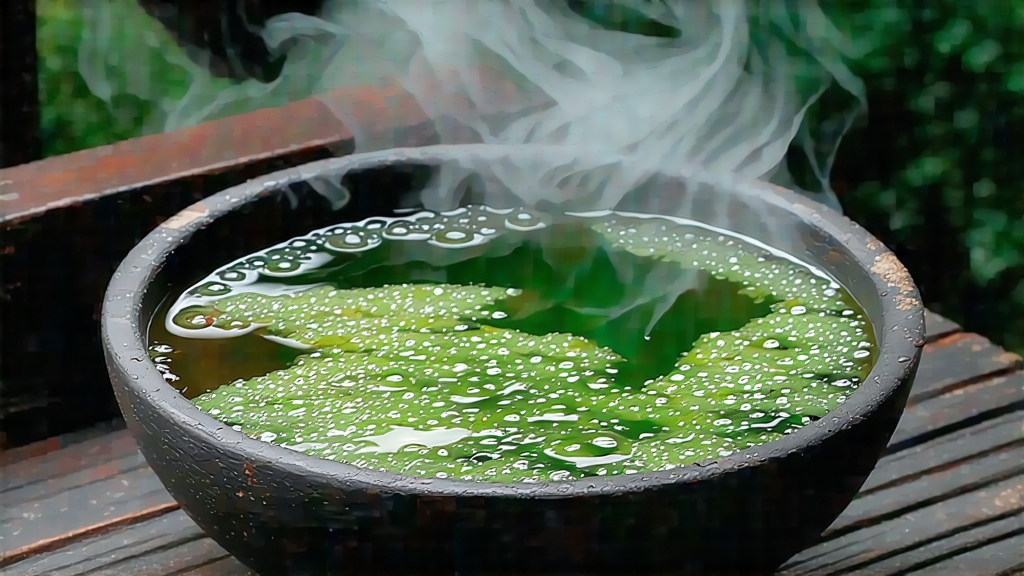
Few leaves in the vast tapestry of Chinese tea carry as much romance and technical intrigue as Tie Guan Yin, the “Iron Goddess of Mercy.” Born in the granite ridges of Anxi, southern Fujian, this oolong has travelled from hidden mountain temples to Parisian cafés, yet it still insists on being tasted on its own terms: slowly, attentively, and more than once. To understand Tie Guan Yin is to witness a dialogue between Qing-dynasty legend, post-modern agronomy, and the quiet persistence of tea artisans who refuse to let a 300-year-old fragrance vanish inside an industrial drum dryer.
Legend first. In 18th-century Anxi, a poor farmer named Wei Yin walked daily past a dilapidated iron statue of Guan Yin, the Bodhisattva of Compassion. Though he could barely feed his family, he swept the shrine and offered incense. One night in a dream the goddess guided him to a cave behind her altar where a single tea shrub shimmered in moonlight. Wei transplanted it, cultivated the bushes, and shared the leaf with neighbours. The infusion was floral like spring orchids, sweet like ripe lychee, and lingered on the palate “like the echo of temple bells.” Gratitude transformed iron into jade; the tea was named Tie Guan Yin—Iron Guan Yin—to honour the moment when devotion became flavour.
History soon parts company with hagiography. Tax records from 1736 show Anxi county already levying a “qing xiang cha” (light fragrance tea) surcharge, suggesting a semi-oxidised leaf was circulating before the Wei family story crystallised. What is certain is that by the late 19th century Anxi growers had developed a unique cultivar—Tie Guan Yin strain—that combined low yield with an unusually high concentration of floral volatile compounds (linalool, geraniol, indole). The leaf was tough, almost leathery, hence the “iron” metaphor; the liquor was soft, hence the “goddess.” Commerce carried it down the Min River to Xiamen port, where European buyers christened it “Tea of the Iron Bodhisattva” and shipped it to London alongside Keemun and Lapsang. By 1935 Tie Guan Yin represented 40 % of Fujian’s tea export, quietly bankrolling schools and railways while the rest of China fractured under war.
Today the cultivar survives in three stylistic lineages that share DNA but speak different dialects of aroma.
-
Qing Xiang (Fresh Aroma): harvested in spring, lightly bruised, oxidised 15-20 %, then blast-frozen in modern refrigerated drums to lock in a bright green colour. The cup is pale jade, the nose a bouquet of white gardenia and honeydew. It is the style most often encountered in Taipei bubble-tea chains and New York specialty cafés.
-
Nong Xiang (Conventional Roast): the same leaf is oxidised 25-30 %, then charcoal-baked over lychee-wood embers for 30-40 hours across two months. The fire drives off moisture while Maillard reactions create notes of toasted sesame, baked yam, and a whisper of pipe tobacco. Liquor turns golden amber; the texture becomes velvety, almost chewable.
-
Chen Xiang (Aged Iron): select nong xiang lots are re-roasted every two years, then sealed in clay jars and left to breathe through subtropical summers. After five years the leaf blackens, the aroma shifts toward dried longan, sandalwood, and antique parchment. Connoisseurs in Guangzhou drink it from yixing pots that have never seen another tea, believing the infusion lubricates joints and soothes the liver.
Regardless of style, the crafting choreography follows five immutable steps that have changed only in scale, not in spirit.
• Picking: two leaves and a bud at dawn when the dew’s surface tension can still hold a dragonfly. Standard: 4.5 cm length, 0.3 g weight, no fingernail bruise.
• Sun-withering: the leaves are laid on bamboo sieves for 20 minutes under 22 °C solar radiation. Cell walls begin to fracture, initiating enzymatic oxidation.
• Rocking in Rattan Drum: the genius of Tie Guan Yin lies in “yao qing”—shaking. Forty kilograms of leaves are tumbled inside a cylindrical rattan cage suspended from the ceiling. The drum rotates 15 times